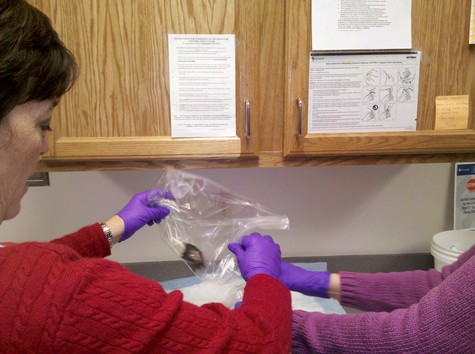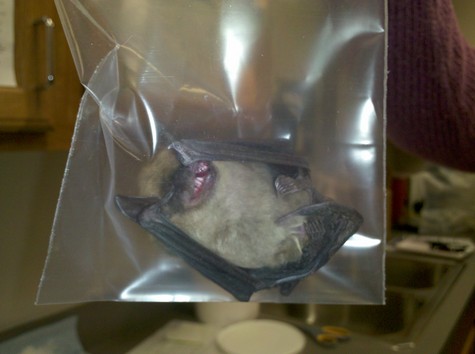It's that batty time of year: Find out what you can do to prevent rabies

Jayne Worthy-Howlett Nursing Supervisor, WCPHD
Rabies is a deadly viral infection that is mainly spread by infected animals. Bats are one of the most common animals that transmit rabies in the U.S., along with raccoons, skunks, foxes and coyotes.
The rabies disease is spread by infected saliva that enters the body through a bite or broken skin. The virus travels from the wound to the brain, and as the virus spreads through the central nervous system, progressive, fatal inflammation of the brain and spinal cord develops.
Worldwide, more than 55,000 people die of rabies every year, and 40 percent of people who are bitten by animals suspected to be rabid are children under 15 years of age.
Learn the three simple things you can do to avoid coming into contact with a rabid bat.
All animal bites and exposures to bats should be reported to the Health Department. We are also available to consult regarding the need for post-exposure prophylaxis, and we coordinate animal testing for rabies, too.
We recently received a call from a man who said he had sat down in his dining room chair and felt something poke his behind. When he reached down to feel for the sharp object, he unknowingly grabbed a bat (which then proceeded to bite his palm).
In a panic, he flung the bat aside, and his brother managed to bash the bat with a pan. They captured it with a shoebox and called our department.

Health workers examine a dead bat.
After doing an assessment over the phone, we instructed the victim to contact a veterinarian who would euthanize and package the bat for submission to the Michigan Department of Community Health Laboratory for rabies testing. We also determined that since our caller had sustained a puncture wound and could not remember his last Tetanus booster, we would need to administer a Tdap vaccine.
When our bite victim came in for his Tdap, lo and behold, he had the bat (still in the shoe box) with him. Since this happened on a Friday and the vet was not in the office, the bat wouldn't be able to be dropped off until Monday. The gentleman wondered if we could take possession of the bat until then.
I contacted the rabies expert at the Michigan Department of Community Health for guidance on just how long the specimen could be stored before it started to decompose. She advised us to have the bat packaged and sent up to the MDCH lab for testing via overnight courier since we were dealing with an actual bat bite.
Mary McCloud, another public health nurse, prepared the packaging supplies for the bat transport, while I double gloved and worked up the nerve to open that shoe box. After assurance that the bat was dead, we packaged the bat and sent if off for rabies testing.

A close-up of the culprit
The next afternoon, a call came from MDCH that the bat had tested positive for rabies (our first positive animal for 2011). The bite victim was immediately notified and instructed to proceed to a local emergency department for Rabies Immune Globulin and the first in the series of rabies vaccine.
The remaining three doses of rabies vaccine are administered over a two-week period following the initial dose. The bite victim has now completed his vaccine series and reports that the experience has been a great conversation starter!
Bat handling instructions:
Bats are frequently found inside people's homes. If you find a bat in your home, do not discard it!
Instead, you should safely collect the bat until the need for rabies testing has been determined. Wear leather gloves, and place a coffee can or a box over the bat. Then use a piece of cardboard with holes punched in it to slide under the can or box, taping this cover firmly to the container.
Contact your local health department or animal control agency to arrange for testing. If a bat is found in the room with a sleeping person, a child, or someone who is mentally disabled or intoxicated, that bat should be collected for rabies testing.
If the bat is unavailable for testing, Post-Exposure Prophylaxis may need to be administered. Your local health department should be contacted for help in determining the need for prophylaxis.
Remember: It's important to get your cats and dogs vaccinated against rabies for their protection!
Jayne Worthy-Howlett is the nursing supervisor at the Washtenaw County Public Health Department and she always has extra gloves nearby. She can be reached at 544-6700.


Comments
Tru2Blu76
Fri, Jul 29, 2011 : 3:48 a.m.
Does Bat Man know about this???
BhavanaJagat
Sat, Apr 23, 2011 : 5:29 p.m.
Thanks for publishing this story and the bat in this case was found to be infected. It is easy to deal with bites if the animal is known and is available for testing. Bites from pet animals could be easily managed. The problem is about animal bites where the animal is unknown or not captured. It is important to note that rabies virus can enter human body if the infected saliva enters the eye. Such Conjunctival route of transmission has been reported and the victim would not know that he has been exposed to the risk of infection. A bite would definitely alert a person and the person who is aware of the danger of Rabies would report his bite and seeks the necessary medical attention. With the Conjunctival route of transmission, the victim reports after onset of Rabies infection which presents with restlessness and anxiety of an undetermined origin. I lost a victim of Rabies who had reported to me after the onset of the infection( brain inflammation) and unfortunately he had no clue as he was not bitten. <a href="http://bhavanajagat.wordpress.com/2010/05/06/fighting-an-enemy-a-story-from-suratgarh-rajasthan/" rel='nofollow'>http://bhavanajagat.wordpress.com/2010/05/06/fighting-an-enemy-a-story-from-suratgarh-rajasthan/</a>
Ann English
Fri, Apr 22, 2011 : 1:20 a.m.
I didn't know that foxes and coyotes could catch and transmit rabies, but they do live around here. I hope that veterinarians today tell pet owners about foxes and coyotes' capacity for spreading rabies, not just bats, skunks and raccoons.
Washtenaw County Public Health
Thu, Apr 21, 2011 : 7:23 p.m.
There is a very effective vaccine for rabies. The vaccine can be administered either in pre-exposure or post-exposure situations. People who work with rabies in laboratory settings and animal control and wildlife officers are just a few of the people who should consider rabies pre- exposure vaccinations. In addition, if you are traveling to a country where rabies is widespread, you should consult your doctor about the possibility of receiving pre-exposure vaccination against rabies. In the United States, post-exposure prophylaxis consists of a regimen of one dose of immune globulin and four doses of rabies vaccine over a 14-day period. Rabies immune globulin and the first dose of rabies vaccine should be given by your health care provider as soon as possible after exposure. Additional doses or rabies vaccine should be given on days 3, 7, and 14 after the first vaccination. Current vaccines are relatively painless and are given in your arm, like a flu or tetanus vaccine.
mars
Thu, Apr 21, 2011 : 4:34 p.m.
Bats are not an effective method of mosquito control in Michigan. In our area, the primary bat species is the Big Brown Bat, which does not eat many mosquitoes. <a href="http://www.michigan.gov/emergingdiseases/0,1607,7-186-25805_25824-75797--,00.html" rel='nofollow'>http://www.michigan.gov/emergingdiseases/0,1607,7-186-25805_25824-75797--,00.html</a>
Sarah Rigg
Thu, Apr 21, 2011 : 1:44 p.m.
Seconding the comments that we should be careful of handling bats but that we shouldn't panic over the presence of bats. They're a necessary part of the eco-system, are generally not aggressive to humans and only bite when cornered (or sat on!) and they're really darn cute, too! I feel sorry for the bat-bitten guy, but I feel sorry for the cute little batty, too. :(
Ann English
Fri, Apr 22, 2011 : 1:02 a.m.
I wonder what species of bat it is that you think is cute. Once I had a coworker who looked, through binoculars, at bats resting in a barn and he was not pleased with what he saw up close; he hadn't realized before how ugly they were.
Trumpet
Thu, Apr 21, 2011 : 1 p.m.
Bat Conservation Internation is a great source of bat information and education... Bats do not seek contact with humans and it would be be a shame if people developed a fear of bats because of the fear of being bitten by a rabid bat. Just as with racoons, skunks and others that can carry rabies, it is important to avoid contact. Bats do eat thousands of mosquitos, and are a "green" mosquito defense - no pesticides being used and thus put into the environment. I agree that this article gives us good information. But I also feel that bats are a huge plus in our environment so more information on them and how helpful they are would be a good counterbalance to any fear of rabies.
Ann English
Fri, Apr 22, 2011 : 1:05 a.m.
I never thought of this before, but one animal that can sicken us through infected saliva (the bat) eats another creation that also can sicken us through its infected saliva (the mosquito), although usually only in subtropical and tropical areas of the world.
DBH
Thu, Apr 21, 2011 : 2:43 a.m.
The CDC has a nice fact sheet on the rabies vaccine. See <a href="http://www.cdc.gov/vaccines/pubs/vis/downloads/vis-rabies.pdf" rel='nofollow'>http://www.cdc.gov/vaccines/pubs/vis/downloads/vis-rabies.pdf</a>
Theresa Bassett
Wed, Apr 20, 2011 : 8:34 p.m.
My question is this....is there a vaccination for humans? If not, why? Thanks! -Theresa
Washtenaw County Public Health
Thu, Apr 21, 2011 : 7:24 p.m.
There is a very effective vaccine for rabies. The vaccine can be administered either in pre-exposure or post-exposure situations. People who work with rabies in laboratory settings and animal control and wildlife officers are just a few of the people who should consider rabies pre- exposure vaccinations. In addition, if you are traveling to a country where rabies is widespread, you should consult your doctor about the possibility of receiving pre-exposure vaccination against rabies. In the United States, post-exposure prophylaxis consists of a regimen of one dose of immune globulin and four doses of rabies vaccine over a 14-day period. Rabies immune globulin and the first dose of rabies vaccine should be given by your health care provider as soon as possible after exposure. Additional doses or rabies vaccine should be given on days 3, 7, and 14 after the first vaccination. Current vaccines are relatively painless and are given in your arm, like a flu or tetanus vaccine.
bedrog
Wed, Apr 20, 2011 : 11:41 p.m.
As of quite a few years ago when my family and i had rabies prevention shots in advance of a stay in a part of the third world where feral dog packs were a commonplace the only approved preventive vaccine in the states was a duck embryo based one to which my then wife proved violently ( as in deaths door) allergic. An alternative existed in France, based on human fetal tissue. Given the highly charged -to- fanatic atmosphere around the more innocuous stem cell research in the U.s in recent years , i'd wonder if the french style vaccine were available here.
bedrog
Wed, Apr 20, 2011 : 8:13 p.m.
...and yet many people, myself included , seek to attract bats outside the house via bat-houses, largely as a way of mitigating mosquitos.. The website of the Austin tx-based 'bat conservation international' has a useful website that addresses the often conflicting claims/concerns about these animals. Austin , of course, has a famous million -plus colony of mexican free-tailed bats under it's congress st. bridge...a major tourist attraction at dusk when they exit in clouds... and little in the way of rabies incidents.
c.dancer
Wed, Apr 20, 2011 : 2:37 p.m.
I didn't know the health department helped out in these situations. Glad to hear!!